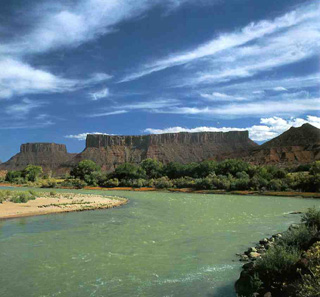
Located near Moab, Professor Valley was used for many films including Cheyenne Autumn (Warner Bros., 1964). Photo: John Murray.
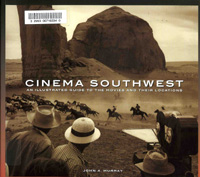

Located near Moab, Professor Valley was used for many films including Cheyenne Autumn (Warner Bros., 1964). Photo: John Murray. |
Filmmakers have been operating in Utah since the silent era. As early as 1925 director John Ford traveled to Promontory, Utah, to film part of his twelve-reel epic film The Iron Horse, shooting at the very place where the historic golden spike was driven, connecting the East Coast with the West Coast for the first time by rail line (which, in a larger sense, signaled the birth of modern America). During the 1930s the area around Kanab in southwestern Utah became known as "Little Hollywood" for the many pictures made there. Later, in the 1950s, the center of gravity shifted to the east, as Moab became the state's major center for filmmaking. Virtually every American director and actor of note has worked in Utah, from Cecil B. DeMille (Union Pacific, 1939) to John Ford (Rio Grande, 1950) to Steven Spielberg (Indiana Jones and the Last Crusade, 1989); from Henry Fonda (My Darling Clementine, 1946) to Clint Eastwood (The Outlaw Josey Wales, 1976) to Jodie Foster (One Little Indian, 1973). If a film has red slickrock and prickly pear cactus desert, cloudless blue skies, and distant mountain ranges, there's a good chance it was shot in Utah.
The story of how Moab became one of the most popular filming locations in the Southwest begins, not surprisingly, with the acclaimed film director John Ford. A detailed account of this essential chapter of Southwestern film history is presented in Bette Stanton's regional history Where God Put the West, Movie Making in the Desert (1994).* [page 78] According to Stanton, who was for many decades a leader of the Moab Film Commission, John Ford had by 1949 completed four successful films in Monument Valley - Stagecoach (1939), My Darling Clementine (1946), Fort Apache (1948), and She Wore a Yellow Ribbon (1949) - and had decided to find a desert location with a slightly different look. For his next project, Wagonmaster, which would dramatize the struggles of the early pioneering Mormons, Ford traveled north on U.S. 191 into southeastern Utah. Once in Moab, he was introduced by the editor of the Moab Times-Independent to local cattle rancher George White (who later founded the Moab Film Commission). George White drove the film director up State Route 128 to Professor Valley and the region of the Fisher Towers on the Colorado River, two of the loveliest spots in the Southwest. The redrock country around Fisher Towers is every bit as beautiful as Monument Valley, but with one added advantage - there is a large river running through it. Ford instantly realized, as he had in 1939 when Harry Goulding had shown him photographs of Monument Valley, that he had found another perfect filming location.
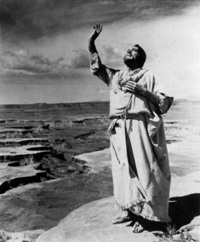
Max Von Sydow portrays Jesus Christ in George Stevens' historical drama The Greatest Story Ever Told (UA, 1965). Courtesy Eddie Brandt's Saturday Matinee. |
Since then over fifty major feature films have been made within a two-hour driving radius of Moab. Everything from action adventure films (Indiana Jones and the Temple of Doom, with Harrison Ford in 1989) to human dramas (Thelma and Louise, with Geena Davis, Susan Sarandon, and Brad Pitt in 1991) to traditional westerns (Geronimo, with Gene Hackman and Robert Duvall in 1993) have used the Moab area as a primary filming location. Directors can find every sort of landscape in the area, from towering spruce and aspen-covered mountains (the 12,000-foot La Sal Range), to wind-swept sand dune fields (Behind the Rocks), to dramatic mile-deep canyons (Island in the Sky), to colorful slickrock (Sevenmile Canyon), to open desert and high prairie (Green River country). The town, which has hosted filmmakers and commercial producers now for over half a century, also has a well-developed support system - lodging, restaurants, supplies, crew and production services - for location shoots.
Generally, film producers work in one of eight public and private areas in Moab. Those areas that involve public land (Arches National Park, Canyonlands National Park, Manti-La Sal National Forest, BLM) require a permit, as in other parts of the Southwest. Permits detail the impacts of filming on habitat and archaeological sites, and also insure the safety of any explosives or pyrotechnics. They also detail restoration efforts, if any, that will be necessary following the construction of sets, use of livestock, and so forth. Film production companies are charged by the government for their activities on public land, and [page 79] these fees can range into many hundreds of dollars per day (there is currently a movement in Congress to increase these fees to approximate those that companies pay for filming in private areas, but the move seems fated, like those to increase grazing fees or mining fees, never to pass).
The public areas in the Moab area include the following:
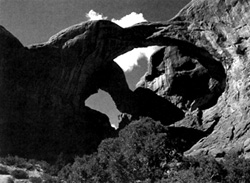
Double Arch in Arches National Park was used in the opening scene of Indiana Jones and the Last Crusade (Paramount, 1989). Photo: John Murray. |
ARCHES NATIONAL PARK AND CANYONLANDS NATIONAL PARK
Because of national park restrictions (film crews must remain on or near paved roads), these two sites are used primarily for commercial shoots - music videos, automobile and fashion advertisements. Automobile advertisements, in particular, often feature a drive through scenic Courthouse Wash and along Park Avenue in Arches National Park (at about mile 5 on the main park road). Despite these restrictions, two major films in recent memory have seen some significant shooting in Arches. Steven Spielberg shot part of the opening sequences of Indiana Jones and the Temple of Doom at Double Arch (in the Windows section of Arches National Park). The scene in which Curly appears to Billy Crystal in City Slickers II was also shot in the Windows section of Arches National Park. Another film that saw some action in Canyonlands was Thelma and Louise (see movie description below). Historically, the parks were used more often, as in the "Sermon on the Mount" scene in The Greatest Story Ever Told, which was shot at the Green River Overlook in Canyonlands National Park (the Green River Overlook is located just off Slate Route 313 about 29 miles south of the intersection with U.S. 191; the general area is known as the Island in the Sky district of Canyonlands National Park).
PROFESSOR VALLEY AND FISHER TOWERS
This area near Moab represents one of the most distinctive landscapes in the Southwest, especially Fisher Towers, a unique sedimentary formation that has appeared, literally, in hundreds of pieces of commercial advertising, as well as in over a dozen major films. The desert valley, with its towering redrock formations, is found along State Route 128 roughly between the confluence with the Dolores River (30 miles east of the intersection with U.S. 191) and the bridge over Castle Creek (16 miles east of the intersection with U.S. 191). Ninety-five percent of the land in Professor Valley is in the public domain (BLM and state land at lower elevations, Manti-La Sal National Forest at higher elevations, Arches National Park north of the Colorado River). Popular filming locations include the George White Ranch (about 14 miles east of the intersection of State Route 128 and U.S. 191 near the confluence of Castle Creek and the Colorado River), Ida Gulch (about 17 miles east of the intersection of State Route 128 and U.S. 191), the Onion Creek area (about 21 miles east of the intersection of State Route 128 and U.S. 191), and the Fisher Towers area (about 22 miles east of the intersection of State Route 128 and U.S. 191). Distinctive geological features in this extensive valley area include Castle Rock, Parrot Mesa, The Porcupine Rim, Adobe Mesa, Fisher Mesa, Priest and Nuns, Totem Pole, Titan Towers, and the Fisher Towers. Although the names may [page 80] not be familiar, the features will be instantly recognizable the first time you drive through the valley (if you've ever been to the movies).
Among the many films made in Professor Valley, several stand out, including Cheyenne Autumn (1964), John Ford's last Western and his final apology to the Indians; Taza, Son of Cochise (1953), with Rock Hudson (of all people) as Taza; and Fade In (1967), an interesting film that actually made Moab the subject of the story. In Fade In Burt Reynolds (Oscar nomination, Deliverance, 1972) played a Moab rancher who falls in love with a member of a film production company that is in town making a picture entitled Blue (that film, made concurrently in Professor Valley, starred Ricardo Montalban and Karl Maiden). More recently, Professor Valley served as a primary shooting location for Geronimo (1993 - see film description below). Other major films made in the area include Wagonmaster (1949 - see film description below), Rio Grande (1950 - see film description below). Battle at Apache Pass (1952), Siege at Red River (1954), Ten Who Dared (1959), The Comancheros (1961), and City Slickers II (1993).
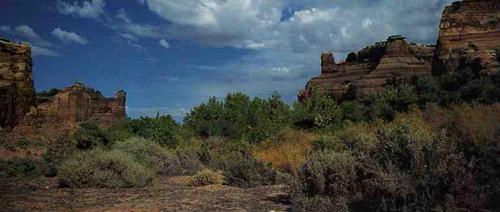
Indiana Jones and the Last Crusade (Paramount, 1989) and Breakdown (Paramount, 1997) were partially filmed in Sevenmile Canyon near Moab. Photo: John Murray. |
BEHIND THE ROCKS DUNES
Of the various dunefields around Moab, this is one of the most popular for filming, with an extensive basin of windswept, coral-colored dunes (reached by a well-marked but primitive access road to the west about 15 miles south of Moab on U.S. 191 - this road is recommended for four-wheel-drive only).
POTASH TRAIL AND SCHAEFER TRAIL
At the end of State Route 279 (the road begins off U.S. 1912 miles north of Moab) there is a scenic road along the Colorado River that leads to the Moab Salt and Potash Mine and Mill. The area has a very unique appearance and has been often used in science fiction films, such as Rocket Man (1996) and Species 2 (1997). The Schaefer Trail, a primitive dirt road, begins at the end of State Route 279 (the road is in the vicinity of Thelma and Louise Point, where the two characters in the film drove their automobile off a cliff).
Although private land is scarce in Grand County and San Juan County, about a dozen ranches around Moab have been used historically in filmmaking. One of the most popular has been the George White Ranch (offering around 700 acres and 380 head of cattle on State Route 128 about 14 miles east of the junction with U.S. 191; also 5 miles south on the Spanish Valley Road). The White Ranch was used as early as 1950 by John Ford for Rio Grande. More recently, the ranch was used in 1993 as a filming location in the retelling of the Geronimo story with Gene Hackman and Robert Duvall. Further south, the Pack Creek Ranch (located at the end of the Spanish Valley Road about 15 miles southeast of Moab, offering 300 acres and around 20 horses) has also seen some shooting. The Dugout Ranch - located about mile 15 on State Route 211 (the road to the Needles District of Canyonlands National Park), offering 2,000 acres and around 700 head of cattle - has been used for filming City Slickers II and other films. Recently, the Nature Conservancy entered into a land preservation agreement with the longtime owners of the Dugout Ranch, a site which is prized both for its scenic redrock and valley location and for its natural wetlands (always scarce in a desert region).
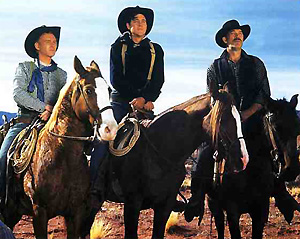
Harry Carey Jr. (Sandy Owens), Ben Johnson (Travis Blue), and Ward Bond (Elder Wiggs) co-star in a picture about a Mormon wagon train's struggle to reach the promised land in John Ford's Wagonmaster (Republic, 1950). Courtesy Eddie Brandt's Saturday Matinee. |
The film starred several gifted young actors of the time, most notably Ben Johnson and Harry Carey, Jr., as well as Ward Bond (as the elder wagonmaster). The narrative focuses on two young cowhands (Johnson and Carey) who elect to join the caravan, and who eventually help to save it from the evil Clegg gang, among others. Much of the picture was shot in Professor Valley along the Colorado River and in Spanish Valley just southeast of Moab (some additional shooting was done in Monument Valley). One of the most beautiful scenes in this richly filmed production - the segment in which Ben Johnson and Ward Bond look for a safe river crossing - is just upriver of the Fisher Towers, along what is today State Route 128 (about 25 miles northeast of the junction with U.S. 191). In the end, Wagonmaster became one of Ford's most successful creations. The film presents, in the Mormons' historic pilgrimage, a metaphor for the longer journey of human life. [page 83] Both are filled with obstacles, both move from the familiar country of the past into the new and often strange landscape of the future, and both are grounded in family, friendship, and community.
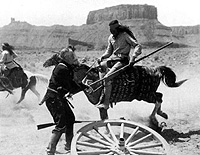
A stunt from one of the battle sequences in John Ford's Rio Grande (Republic, 1950). Courtesy Eddie Brandt's Saturday Matinee. |
Although several parts of Rio Grande were shot in Monument Valley, most of the filming was done in Professor Valley north of Moab. The fort, which serves as the geographic and narrative center of the picture, was built on George Whites ranch in Professor Valley (south of State Route 128 about 15 miles east of the junction of U.S. 191 and State Route 128). Additional important scenes, including the various Indian attacks, were filmed in Professor Valley at the same location, in Ida Gulch (about 1 mile east of the junction of Castle Valley Road and State Route 128), and at Onion Creek (about 4 miles east of the junction of Castle Valley Road and State Route 128).
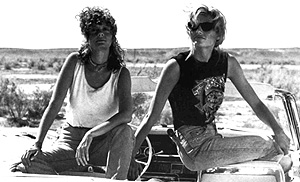
Susan Sarandon as Louise Sawyer and Geena Davis as Thelma Dickinson are two best friends on a four-day race against time after a weekend getaway goes awry in Ridley Scott's Thelma and Louise (MGM, 1991). Courtesy Photofest. |
Thelma and Louise was shot almost entirely in and around Moab, including the ghost town of Cisco (take exit 212 on 1-70 and drive west 5 miles), Thompson Springs (take exit 190 on 1-70 and drive west 6 miles), La Sal (9 miles east of U.S. 191 on State Route 46), Arches National Park (some of the night-driving footage was shot on the park [page 85] road in the vicinity of Courthouse Wash and Park Avenue), and along U.S. 191 north and south of Moab. The climactic scene, in which the two women drive their automobile off a cliff in the Grand Canyon rather than surrender to the FBI, was actually shot on a rim below Dead Horse Point on the Potash Trail (follow State Route 279 west of U.S. 191 for 15 miles). One of the crash dummies used in this scene can be seen at the offices of the Moab to Monument Valley Film Commission in Moab (50 East Center #1).
Geronimo
The life and times of Geronimo have been represented many times in film. The Chiricahua Apache leader is one of the few historical figures of the old Southwest whose name draws a nod of recognition across the world, from Paris to Peking. Born around 1840 near the headwaters of the Gila River in New Mexico (in what is today the Gila Wilderness), Geronimo was a peaceful medicine man until his wife and children were killed in a massacre in Mexico. For many decades after (not unlike the wronged protagonists of High Plains Drifter or The Outlaw Josey Wales) Geronimo waged a relentless war against all who violated his homeland, the sprawling borderland region historians now refer to as Apacheria. After years on and off the reservations, he finally surrendered in 1886 and spent the rest of his life under military supervision in Florida and Oklahoma. Shortly before his death, in one of the ironies of history, Geronimo rode a horse in the inaugural parade of Theodore Roosevelt (who steadfastly refused to release him to go home to the Southwest, though probably more out of concern for Geronimo's safety than anything else). Geronimo's autobiography, dictated to a journalist before his death - Geronimo, His Own Story, edited by S. Barret (1905) - is highly recommended.
The 1993 remake of this story focuses on the campaign to subdue Geronimo during the 1885-1886 period (John Bourkes 1891 book On the Border with Crook, a related account, is also an excellent read). The picture featured two major stars, both Oscar-winners: Robert Duvall (for Tender Mercies; see Texas chapter) and Gene Hackman (for The French Connection, 1971). While the film (like all non-documentary films based on history) works loosely and at times imaginatively with the facts, Geronimo is in the end a fairly realistic picture, with particularly strong performances by both Duvall and Hackman. Much of the filming for the picture was shot in Professor Valley, including the Onion Creek area. Additional location shooting was done at the Needles Overlook (about 40 miles south of Moab on U.S. 191, turn west on State Route 211 and drive 24 miles west to the end of the road), on the Potash Trail, and on the sand dunes in the Behind the Rocks area. This picture made fine use of the Professor Valley landscapes, with some of the best local shooting since the days of John Ford.
Whenever John Ford was in Monument Valley and needed to film Indians crossing a river in a massed attack (as in She Wore a Yellow Ribbon), he drove the crew in convoy fashion up U.S. 163 twenty-five miles to Mexican Hat, Utah. Upstream of the small town there are long open stretches of flood plain, cottonwood stands, and sandy beach along the San Juan River. In 1998, this river area between Bluff and Mexican Hat gained national attention as three anti-government survivalists hid out in the area, eluding FBI agents, Navajo trackers, are! local police officers (one committed suicide, two are still at large). Novelist Tony Hillerman is said to be writing a novelized version of the incident, which involved the killing of a police officer and may ultimately result in yet another Southwest outlaw film, although with a dark, modern twist.
Valley of the Gods, a somewhat similar but scaled-down version of Monument Valley, is located just north of Mexican Hat (it can be accessed from either U.S. 163, 5 miles north of Mexican Hat, or from State Route 261, 7 miles north of Mexican Hat). This area of pinnacles and buttes has been used more recently than in the past, perhaps in part because it is located on a fairly obscure parcel of public land and [page 87] film permitting is easier than on the heavily visited tribal lands of Monument Valley to the south, Valley of the Gods can be seen in Forrest Gump (1993) and in To Wong Foo (1994, with Patrick Swayze and Wesley Snipes).
Old Pariah is one of the secret treasures of the Southwest. Anywhere else in the country, it would be a national park. Here it is just another sonorous place-name on a sprawling Bureau of Land Management map, visited perhaps by a few thousand people a year. With its quiet nestled valley, peaceful desert river, and nearby hills colored in rainbow bands of purple, orange, yellow, red, and blue clay, the old ghost town has found itself used as a film set since the beginning. During the 1920s, Zane Grey's stories were transformed at Old Pariah into such now-forgotten silent films as Heritage of the Desert. Later, major productions were set, either partially or wholly, at Old Pariah, including Western Union (1941, with Randolph Scott, Robert Young, and John Carradine), The Greatest Story Ever Told (1965), Mackenna's Gold (1968, with Gregory Peck, Omar Sharif, Edward G. Robinson, and Eli Wallach), and, most notably, The Outlaw Josey Wales (1976, see film description below).
The original townsite was established in 1870 by Mormon pioneers. In its early days, it was visited by such notables as John Wesley Powell (the explorer who first rafted down the Colorado River through the Grand Canyon). Severe flooding eventually forced the farmers out. A small gold mine operated in the area around 1911, but it too was eventually abandoned. The Old Pariah Movie Set is now maintained by the BLM as a historic site, and is often visited by elderhostel groups and other tour groups from Kanab and Page. To reach the area, drive east of Kanab for 30 miles on U.S. 89 and turn north on the dirt BLM road. Drive north approximately 4 miles and park on the south side of the river. The ghost town is within sight to the north. The dirt access road to Old Pariah is impassable to non-four-wheel-drive vehicles after rain or snow.

Clint Eastwood directs and plays the lead role of Josey Wales, a former Confederate soldier who is avenging the murder of his family, in The Outlaw Josey Wales (Warner Bros., 1976). Courtesy Photofest. |
Much of the filming for The Outlaw Josey Wales (the story is based on the Forrest Carter novel) was done in southern Utah at the beautiful Old Pariah location. The cinematography by Bruce Surtees is exceptional, but of course he had the striking southern Utah scenery to help him. The picture was directed by Eastwood. Anyone who has ever been the subject of a gross injustice (who hasn't?) will be able vicariously to avenge the wronged in watching this film.
[page 86] Few writers have seen so many works adapted into film, or had such a powerful influence in the genre as Zane Grey. Though forgotten by most, such pioneering Western films as Heritage of the Deseret and Riders of the Purple Sage - both based on popular Grey novels [about Latter-day Saint/Mormon characters] - went a long way toward establishing the Western as a distinct cinematic form, and to paving the way - in term of setting, theme and character - for such later classics as Stagecoach and High Plains Drifter. Grey had the most unlikely of beginnings, considering the ultimate trajectory of his life. Born in 1872 in Zanesville, Ohio, he went on to become, of all things, a dentist. Like many working professionals, Grey secretly dreamed of becoming a successful novelist. Unlike most, though, he actually acted on his ambitions and began seriously cultivating his talent. After self-publishing his first novel (a disaster entitled Betty Zane), Grey traveled to Arizona at the urging of his wife, who at that time was his sole fan and cheerleader. After returning to the east, Grey holed up in a cottage and wrote The Heritage of the Desert (1910), which remains one of his finest books. The two later Riders of the Purple Sage, another classic, appeared. Many of the early silent films based on Grey's novels were shot on location at Old Pariah, west of Page, Arizona, on land currently managed by the Bureau of Land Management. Others were shot in the hills around Los Angeles, particularly in what is no the Santa Monica National Recreation Area near Malibu. Paramount's first sound Western, which came out in 1930, was based on Zane Grey's novel By the Light of the Western Stars. Starring Richard Arlen, The Light of the Western Stars was produced by Harry Sherman, who would later create the enormously successful Hopalong Cassidy (William Boyd) series with Paramount. Zane Grey died in 1939, the same year John Ford's Stagecoach appeared, and with it a whole new form of the Western Grey had helped create. |
During the 1930s, Kanab was often referred to as "Little Hollywood" for the many cowboy and feature films shot in the area. Today, about all that remains of this era is the "Frontier Movie Town" (297 West Center, Kanab), which features a movie set (period Western town), museum, and several partial sets from big-screen productions. Some of the first films in Utah, such as Tom Mix's 1924 Deadwood Coach, were filmed in the picturesque Kanab Canyon area northwest of town [page 89] (4 miles north on U.S. 89, turn east and follow the access road into the Kanab Creek Canyon). A movie town was later built at the Kanab Canyon site, remnants of which can still be found several miles up the access road. Film companies also utilized the area now designated as the Coral Pink Sand Dunes State Park southwest of Kanab (drive north on U.S. 89 for 13 miles and then turn left or south on the dunes access road; follow this road south roughly 10 miles). Such films as Arabian Nights (1942, with Leif Erickson, Jon Hall, and Maria Montez) were filmed on the sand dunes. Another popular filming location around Kanab was the ghost town of Grafton (about 42 miles west of Kanab on State Route 9), which is set along the scenic Virgin River.
One of the better films to feature the landscape in the vicinity of Kanab during the "Golden Age of Film" was Buffalo Bill (1944), which starred Joel McCrea as Buffalo Bill, Maureen O'Hara as Louise Cody, and, if you look hard enough, future two-time Academy Award-winner Anthony Quinn (Viva Zapata!, 1952 and Lust for Life, 1956) as Yellow Hand. The river battle (the best scene in the film from a technical standpoint) was actually filmed on Kanab Creek (with a small dam to back the water up). Director William A. Wellman (a decorated veteran of World War I) had one year earlier directed the film version of The Ox-Bow Incident and would later direct Track of the Cat (1954).
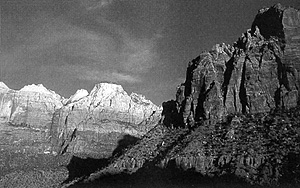
The Kanab Canyon area was used extensively by filmmakers during "The Golden Age of Film," but was also used for Gunsmoke (CBS, 1955-1975) and other television series. Photo: John Murray. |
[page 90] The name of Robert Redford will forever be associated with the deserts and mountains, rivers and canyons, mesas and buttes, arches and arroyos, slickrock and sagebrush of his adopted state, Utah. No other member of the motion picture community has ever been so committed to preserving the imperiled landscapes of the American West. When President Clinton stood on the South Rim of the Grand Canyon in September 1995 and signed the executive order creating the new 1.8 million acre Grand Staircase-Canyons of the Escalante National Monument, Redford was nearby, having played a quiet but active role in advancing the much needed proposal. Wherever there has been an environmental battle on the Colorado Plateau in need of a leader, Redford has been there, working hard to protect the unique scenery that is not only a vital part of American cinema, but also an essential component of American democracy. Charles Robert Redford, Jr., was born on August 18, 1937, in Santa Monica, California. After a brief stint at the University of Colorado, Boulder, on a baseball scholarship Redford moved to Europe in 1957 to study painting (as did film director John Huston early in his life). A year later Redford returned to New York to pursue both art and his newfound passion, acting. He made his stage debut in 1959 in a Broadway play, Tall Story. Four years later his lucky break came with a lead role in the Broadway comedy Barefoot in the Park. Soon Redford began appearing in popular television programs. Redford regularly played small parts on television and in film through the 1960s. He was abruptly catapulted to stardom following the success of Butch Cassidy and the Sundance Kid (1969). The film was shot on location in southeastern Utah (at Grafton, a ghost town in the vicinity of Zion National Park) and in southern Colorado (Animas Canyon near Durango). There followed such popular films as Downhill Racer (shot at Loveland Ski Basin in Colorado), Jeremiah Johnson (shot in Provo Canyon in Utah), and The Electric Horseman (also shot at the Grafton, Utah, site, as well as in Reno, Nevada). Surprisingly, Redford's Oscar came not for acting but for directing (Ordinary People, 1980). More recently, he has focused on films that are as much a revelation of wild nature as they are of human nature, including A River Runs Through It (1994) and The Horse Whisperer (1998). All of this is not bad for an accountant's son from southern California who could just as easily have followed in his father's professional footsteps. The fact that Redford chose what the poet Robert Frost called "The Road Not Taken" has forever changed the face of cinema, and the landscapes of the Southwest. |
Butch Cassidy and the Sundance Kid
It's not often that a modern Western wins three Academy Awards, but Butch Cassidy and the Sundance Kid did just that: Best Script, Best Cinematography, and Best Song ("Raindrops Keep Fallin' on My Head"). The film was also nominated for two others (Best Director and Best Film). In addition to this Butch Cassidy and the Sundance Kid was one of the most successful movies of 1969 at the box office, grossing over $30 million - all in the same year that sixty-two-year-old John Wayne [page 91] won his first Oscar (for portraying federal marshal Rooster Cogburn in True Grit). Seen at the distance of several decades, the film seems particularly reflective of its turbulent time, as a pair of affable outlaws were cast as popular anti-heroes. The film came out during a year when anti-war dissidents were becoming cultural anti-heroes as they demonstrated against the Vietnam War. In this sense, the film, one of the first major anti-Westerns, became a subversive allegory used by its makers to protest, obliquely, government policy (with rail baron E. R. Harriman representing President Richard Nixon).
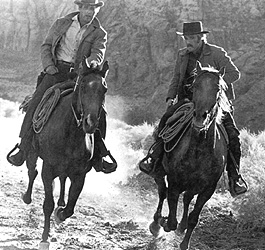
Paul Newman as Butch Cassidy and Robert Redford as the Sundance Kid portray affable outlaws in George Hill's Butch Cassidy and the Sundance Kid (20th Century Fox, 1969). Courtesy Photofest. |
Much of the early part of the film was shot on location in southwestern Utah at Grafton, a deserted Mormon community on the Virgin River near Zion National Park (6 miles west of Springdale on State Route 9). The surrounding scenery - much of it to the north actually in Zion National Park - provided a spectacular backdrop. An abandoned adobe church in the ghost town was converted into a schoolhouse, and one other structure was built, but the rest of the landscape remained unchanged. The film was shot at this location in October and November of 1968, and the autumn foliage along the Virgin River was at its lovely peak - yellow cottonwoods, orange alders, and russet-red scrub oak (all against that chromium-blue Utah sky). It was at the Grafton site that one of the three musical sequences were shot, (Paul Newman playing on the bicycle with schoolteacher Edda Place (Katharine Ross) to Burt Bacharach's Oscar-winning lyric "Raindrops Keep Fallin' on My Head"). Director Hill opted for a more modern score in the film, as opposed to traditional period music, because he believed the characters were more contemporary in their carefree outlook and rebellious manner of living.
Viewers will note that the film has a washed-out, almost bleached quality - this results, according to the documentary, from the cinematographer (who would also win an Oscar) regularly shooting into [page 92] sunny, backlit landscapes; intentionally overexposing the film two or three stops; and introducing a lot of dust and smoke into the scenes to create a slightly hazy effect. Also, many shots of the actors are through objects - such as foliage - which makes the audience actively search for the characters, and also pay closer attention to the action and especially to the dialogue. Parts of the film were also shot in the Animas Canyon north of Durango, Colorado (see Colorado chapter), and in the tropical highlands between Acapuico and Mexico City (the Bolivian sequence).
The last image in the film - during the climactic gunfight with the Bolivian Army - was, according to Director Hill, actually shot with an 8 x 10 large-format camera. The black-and-white image, slowly tinged with sepia as the shooting went on and on, quietly created an abstract, nostalgic closing for the film. Contrast this with the violent, up-close, slow motion deaths of Faye Dunaway and Warren Beatty in Bonnie and Clyde (1968). Like that other influential Western, Stagecoach (1939), Butch Cassidy has become a virtual anthology of innovative cinematic techniques that have since been widely emulated and imitated.
Recently the American Film Institute listed Butch Cassidy and the Sundance Kid as one of the one hundred most influential films of the twentieth century. In this respect, it was one of only a handful of other films with Southwestern settings - Stagecoach (1939), The Grapes of Wrath (1940), The Treasure of the Sierra Madre (shot in Mexico, 1948), High Noon (1952), Giant (1956), The Searchers (1956), Bonnie and Clyde (1967), and Easy Rider (1969) - so honored. It seems certain that Butch Cassidy and the Sundance Kid will endure, both because it is so representative of an axial moment in American history, and because it tells a good story with strong characters so well (more easily said than done).
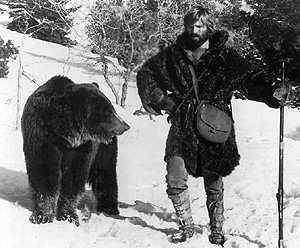
Robert Redford as Jeremiah Johnson is a man who becomes disenchanted with civilization and movies to the wilderness in Sydney Pollack's Jeremiah Johnson (Warner Bros., 1972). Courtesy Eddie Brandt's Saturday Matinee. |
BUTCH CASSIDY HOME (5 miles south of Circleville on U.S. 89)
Butch Cassidy (whose real name was Robert Leroy Parker) was a real-life historical character. [He was a Mormon, raised in a family that belonged to the Church of Jesus Christ of Latter-day Saints, although he lapsed into inactivity prior to his career as an outlaw.] His home can still be seen in the midst of the beautiful southern Utah landscape where he made the legend that was later immortalized in the 1969 film Butch Cassidy and the Sundance Kid. Butch Cassidy's sister publicly stated in her later years that he had not been killed in Bolivia, but had actually returned to the United States and lived under an assumed identity.
SUNDANCE FILM INSTITUTE (P.O Box 16450, Salt Lake City, 84116)
Every year Robert Redford's Sundance Film Institute previews the work of independent filmmakers at the Sundance Festival in Park City in mid-January. The respected festival attracts major actors, directors, producers, and critics.
GOBLIN VALLEY STATE PARK (located about 40 miles south of Interstate 70, exit 147, via State Route 24)
Goblin Valley State Park has redrock formations every bit as striking as those found in Arches National Park and Canyon lands National Park, with one advantage - it is a remote and little-visited state park (meaning that film permits are easier to obtain). The park has been featured in films such as City Slickers (1991).
MOAB TO MONUMENT VALLEY FILM MUSEUM (Moab)
Located in downtown Moab (50 East Center, #1), and always attended by the affable Kari Murphy, the museum is a great place to learn more about the rich film history of the area. The museum includes movie posters, stills, and props.
PROVO (located about 40 miles south of the state capitol of Salt Lake City, via Interstate 15)
The film Footloose (with Christopher Penn, Sarah Jessica Parker, and John Lithgow, 1984), which featured Kevin Bacon in the early stages of his career, was partly filmed in Provo, including the flour mill which can be seen from the Lehi exit of Interstate 15. Robert Redford's popular ski resort Sundance (located east of Provo via U.S. 189 and State Route 92) served as one of the locations for his 1972 film Jeremiah Johnson, based on [Mormon writer] Vardis Fisher's novel Mountain Man. Parts of the film were also shot in the nearby Uinta National Forest.